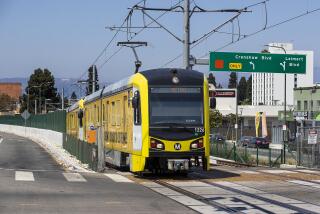Schabarum Seeks Support for Regional Bus System
- Share via
Los Angeles County Supervisor Pete Schabarum is carrying his anti-RTD crusade to the Southeast, seeking support for creation of a new transportation authority that would offer regional bus service to the area’s 23 cities.
Patterned after the fledgling Foothill Transit Zone in the San Gabriel Valley, Schabarum’s Southeast proposal is in the early stages of study. However, the county Public Works Department already has concluded that a Southeast Transit Zone could save $5 million if it took over eight routes from the Southern California Rapid Transit District.
Schabarum, a persistent critic of the RTD, contends that transit zones contracting with private bus operators could substantially improve suburban bus service between cities and to Los Angeles. He won approval of the San Gabriel zone despite the opposition of RTD and its unions, but their continued legal attacks have blocked Foothill’s scheduled start of service this summer.
At this point the supervisors are only asking city councils to support the study, which the county is conducting and paying for. Completing the study and establishing the framework for a new agency will cost the county an estimated $150,000. Schabarum’s office says seven of the 23 cities in the Southeast section of the county have endorsed the effort. The proposed transit zone excludes Long Beach.
Spokesmen for several communities indicated that their councils’ support was motivated more by curiosity than dissatisfaction with RTD service. “They are very much interested in seeing what kinds of potential savings” might be achieved with a new bus system, said Catherine Cole, Norwalk’s assistant transportation director.
Some Councils Declining Invitation
A few councils are declining Schabarum’s invitation to participate in the study. In Commerce, for instance, the city filed the proposal, a polite way of ignoring it. “Right now they have one guinea pig going, they shouldn’t start them all over,” said Daniel Gomez, Commerce transportation director, referring to the stalled Foothill Transit project.
Commerce officials are not opposed to the Southeast proposal, Gomez added, they just think it is premature to pursue before the Foothill experiment has had a chance to succeed--or fail.
The proposal was also filed away in Cudahy. That city is represented by County Supervisor Edmund Edelman, who opposes the breakup of RTD to establish new transit zones. “We’re not going against our supervisor,” Cudahy City Manager Gerald Caton said.
Other cities, while endorsing the study, are concerned that they might be required to divert their transportation money from their own municipal systems to a new regional transit authority. Most Southeast cities operate some type of transportation system, ranging from a full-fledged local bus system to dial-a-ride pickups for the elderly and handicapped.
To gain final county approval, a Southeast Transit Zone would have to be adopted by at least three contiguous cities or an area covering a minimum of 50 square miles--slightly less than a third of the Southeast’s 165-square-mile area.
As proposed, the Southeast zone would at first concentrate on taking over RTD lines, rather than municipal lines. The eight RTD routes recommended for transfer to the zone include three express routes running from Southeast communities to Los Angeles. Altogether, RTD operates 34 routes in the Southeast, according to a county report. The eight were chosen because they meet the criteria for transit zone routes: they are express lines or fall entirely or primarily within the zone area.
With initial annual costs projected at about $7 million, the new bus system would be funded mostly with fares and county transportation funds now used for RTD’s Southeast operation. Participating communities would also have to contribute 5% of the total zone budget.
Schabarum’s press deputy, Judy Hammond, said a transit zone “can do the job better at a cheaper price” than RTD because it would be locally controlled and would contract with private operators who would have to provide good, efficient and courteous service to maintain their contracts. A county demonstration project conducted in connection with the Foothill zone has proven that private operators can increase ridership and reduce costs, Hammond said.
RTD Often Criticized
The oft-criticized RTD is funded and governed in much the same way as the proposed zone. Its operating budget is drawn from fares, county transportation money and some federal transit funds. It is governed by a board of county and city representatives. But the bus authority is legally forbidden to contract with private bus operators, a key difference, say zone proponents who also argue that a transit zone could be more tightly controlled because it covers a much smaller area than the sprawling RTD.
Schabarum first turned to the transit zone concept about four years ago out of frustration with RTD’s service cutbacks in the San Gabriel Valley, which he represents. “The only alternative he saw at that point was to start a transit zone,” Hammond said. Since Schabarum, who represents eight Southeast cities, believes this area is also neglected by RTD, he is advocating another zone. “Many of the problems are the same in terms of poor service in a suburban area,” Hammond said.
An RTD spokesman had little comment about the proposed Southeast zone, but in a lawsuit filed against the Foothill project, the RTD insists it cannot legally forfeit its routes to authorities such as Foothill. RTD drivers and mechanics, complaining that their jobs are threatened, have also taken legal action against the Foothill zone. They recently obtained a judge’s order blocking the zone from beginning service while the lawsuits wend their way through the court system.
In the meantime, Schabarum, chairman of the county Transportation Commission, wants to move ahead with the Southeast study.
More to Read
Sign up for Essential California
The most important California stories and recommendations in your inbox every morning.
You may occasionally receive promotional content from the Los Angeles Times.














